Get PeakVisor App
Sign In
Search by GPS coordinates
- Latitude
- ° ' ''
- Longitude
- ° ' ''
- Units of Length

Yes
Cancel
Share ×

Scan the QR code and open PeakVisor on your phone
❤ Wishlist ×
Choose
Delete
The Lake George Wild Forest is an outdoor recreation destination situated in the northern region of the US state of New York. The forest is located in the southeastern part of the Adirondack Park. There are 36 named peaks in the wild forest, the highest and most prominent of which is Black Mountain (2,648 ft/807 m).
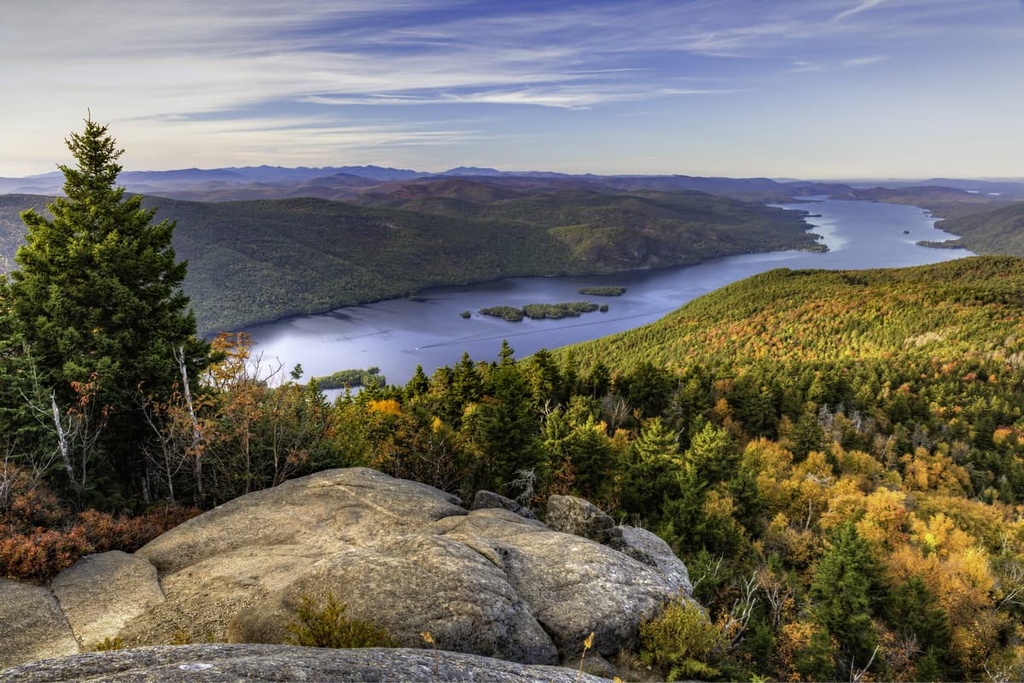
The Lake George Wild Forest is located in Upstate New York in the southeastern region of the Adirondack Park. The forest encompasses 71,133 acres (28,786 ha) of land surrounding Lake George.
Great Sacandaga Lake is situated to the southwest of the forest while Lake Champlain is located to the northeast. The Lake George Wild Forest is dominated by forested hillsides and it encompasses land in Warren and Washington counties.
The northern border of the forest is marked by the Warren County line, while the Hudson River forms the forest’s western border. Both the southern and eastern borders of the forest are marked by the boundaries of the Adirondack Park.
Lake George is the focal point of the forest as many of the trails, viewpoints, and activities in the area are centered around this stunning body of water. The surrounding forests in the region feature alternating ridges and valleys, which is similar to the landscape found throughout much of the Adirondacks.
The aftermath of widespread forest fires that occurred during the early twentieth century in the region can be seen in the Lake George Wild Forest to this day. Many of the tallest peaks in the region are heavily forested while some contain rocky bluffs that offer sweeping views of the surrounding mountains.
Other bodies of water in the forest include Friends Lake, Loon Lake, and Schroon River. Since the forest is situated on the southeastern border of the Adirondack Park, it allows the Lake George Wild Forest to act as a gateway into the rest of the region.
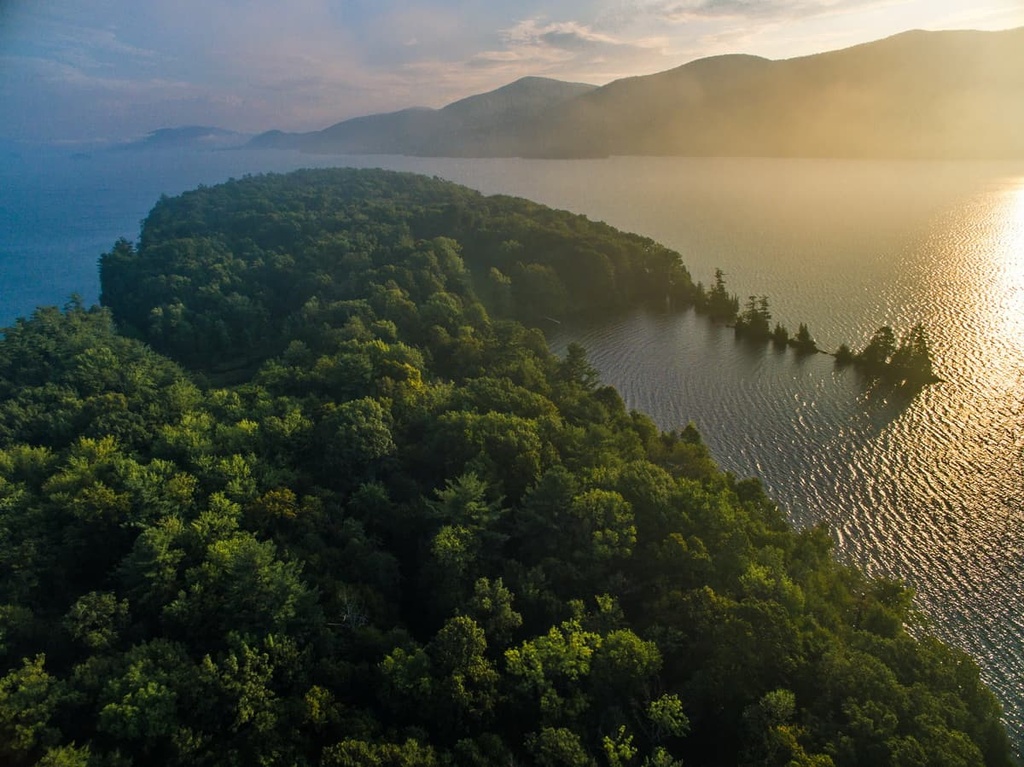
Additionally, the Lake George Wild Forest lies near numerous other parks and forests for outdoor recreation. For example, along the shores of Lake George lie both the Shelving Rock Area and the Hudson River Special Management Area.
The forest is also located to the east of the Wilcox Lake Wild Forest. The Ferris Lake Wild Forest lies to the southwest of the Lake George Wild Forest, while the Jessup River Wild Forest and the Vanderwhacker Mountain Wild Forest can be found to the northwest. The Hammond Pond Wild Forest is also nestled directly to the north of Lake George.
The peaks and ridgelines within the Lake George Wild Forest are part of the Adirondack Mountains, which are primarily contained within the Adirondack Park. The range consists of a massif that spans across Upstate New York.
The Adirondack Mountains form a circular dome that covers 5,000 sq. miles (13,000 sq. km) of terrain throughout northern New York. The rocks found at the core of the range began forming around 2 billion years ago. During this time, the range was situated near the equator along the seafloor.
The range is believed to have been slowly uplifted around 1.5 to 1 billion years ago during the Grenville orogeny. This long mountain-building process created immense amounts of heat and pressure, transforming the sedimentary rocks of the region into metamorphic rocks. Today, the core of the peaks consists of lithologies and minerals from the Proterozoic.
Despite the fact that the Adirondack Mountains are located in the eastern part of the United States, they are not geologically part of the Appalachian Mountains, which encompass much of the eastern coast of North America from northern Alabama in the US to the Canadian province of Newfoundland and Labrador.
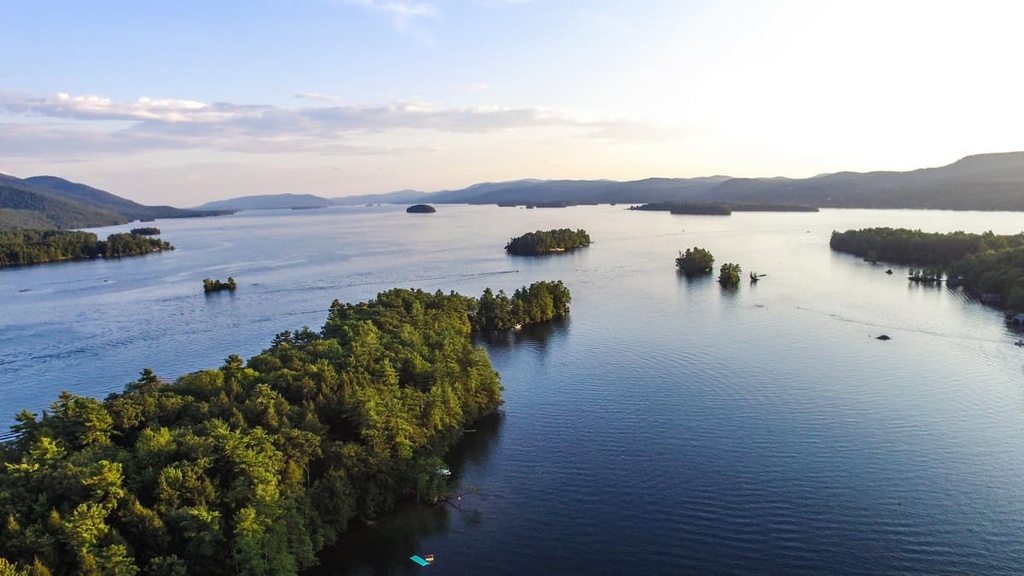
The peaks in the Lake George Wild Forest began taking their current shape around 600 million years ago. During this time, a shallow sea covered much of the landscape. This sea further carved out the region as the waters retreated. Further uplift in the area occurred around 10 million years ago thanks to a hot spot that was located beneath the Earth’s crust.
Though the Adirondack Mountains are relatively low in elevation when compared to the Rockies or the Alps, they used to be much taller than they are today.
The range itself has been heavily eroded over time. In particular, much of Upstate New York was covered by the Laurentide ice sheet during the last glacial maximum. As temperatures began to rise, the glaciers retreated, shaping the landscape even further and leaving behind the alternating valleys and ridges that currently exist in the region.
Some of the major peaks located within the Lake George Wild Forest include Black Mountain, Black Spruce Mountain, Fivemile Mountain, Buck Mountain, and Catamount Mountain.
The vast network of wild forests in the region around Lake George allows for a variety of both flora and fauna to thrive. The Lake George Wild Forest, along with the nearby Wilcox Lake Wild Forest, is home to some of the southernmost sections of the eastern forest-boreal transition ecoregion.
The forested hillsides that surround Lake George are dominated by a variety of spruce, pine, and deciduous trees. Small sections of the forest feature swamps, bogs, and marshes. The highest elevations in the forest feature tree species like black spruce, red spruce, and balsam fir.

Larger mammals found in the forest include white-tailed deer, red foxes, bobcats, gray foxes, and black bears. Populations of beavers, raccoons, and porcupines are also common in the region. The forest is also known for its bird watching opportunities as it is home to species like Canada jays, black-backed woodpeckers, and boreal chickadees, among others.
The bogs and marshes of the region are typically home to great blue herons, painted turtles, and spotted salamanders. Lake George also provides the ideal habitat for a variety of fish. Some of the more common fish species found in the region’s lakes and rivers include lake trout, largemouth bass, smallmouth bass, Atlantic salmon, northern pike, yellow perch, and chain pickerel.
The Adirondack Mountains, including the land within and surrounding the Lake George Wild Forest, have been home to humans for thousands of years. Remnants of settlements and artifacts in the region date back as early as 15,000 to 7,000 BCE.
This region also marks the ancestral homelands of the Oneida (Onʌyoteˀa·ká) and Mohawk (Kanienʼkehá꞉ka). The Oneida and Mohawk traditionally had settlements throughout the region and would use the forested hillsides in the area as their hunting grounds. The Haudenosaunee (Iroquois Confederacy) was founded by the Oneida and Mohawk alongside the Seneca, Cayuga, and Onondaga.
The first recorded contact between European settlers and the Indigenous peoples in the region occurred in 1609. This meeting was followed by a number of battles over the following century as the Haudenosaunee fought to protect their homelands from the settlers.
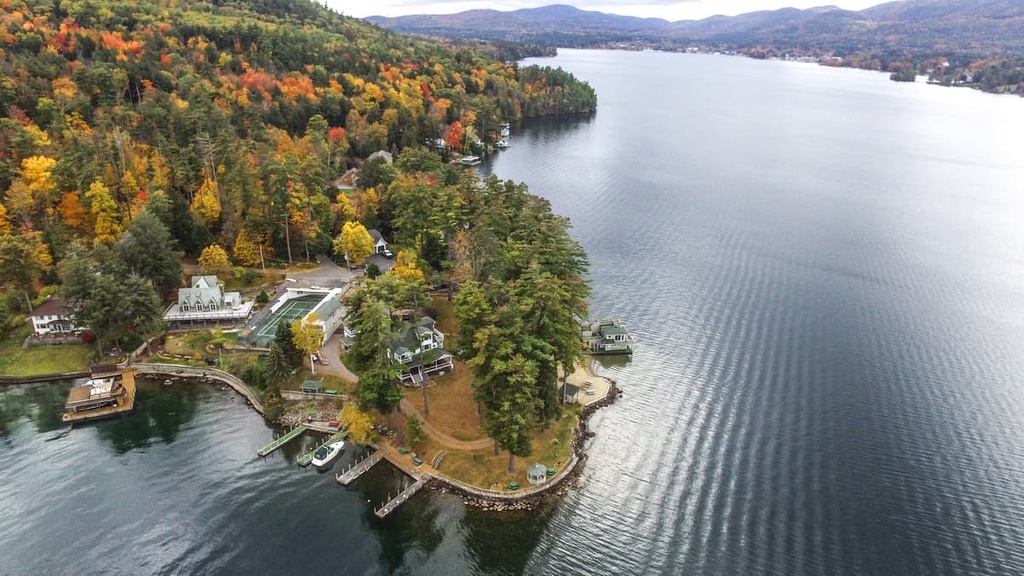
The number of battles that took place in the region began to dwindle as the Haudenosaunee were decimated by the arrival of diseases such as smallpox, to which they had no natural immunity. Due to the loss of many tribal members, many Oneida were forced to join the side of the US during the American Revolutionary War. The Oneida often worked around Fort Stanwix as scouts for the rebel troops.
The Oneida and the other Haudenosaunee nations signed the Treaty of Canandaigua with the US in 1794. The original treaty granted the Haudenosaunee some 6 million acres (2,428,100 ha) of land, primarily in the state of New York.
However, in the following decades, the US dishonored the treaty and deprived the Oneida of their land. In fact, by the 1920s, the Oneida Nation held only a few dozen acres of land—a far cry from the millions of acres that it was promised by the US government.
This vast reduction forced many Oneida people to relocate to present-day Wisconsin and northward into parts of Canada. Today, the Oneida are organized into four nations, two in the US and two in Canada. This includes the Oneida Indian Nation in New York, the Oneida Nation of Wisconsin, Oneida at the Six Nations of the Grand River, and the Oneida Nation of the Thames.
At the same time, widespread logging in the Adirondack Mountains led conservationists to work to protect the region. The Adirondack Park was designated as a Forest Preserve in 1885 in an effort to prevent further destruction to the region.
Today, the Adirondack Park is home to a plethora of Wild Forests, including the Lake George Wild Forest. Today the forest features roughly 100 miles (161 km) of hiking trails and 63 primitive tent campsites.
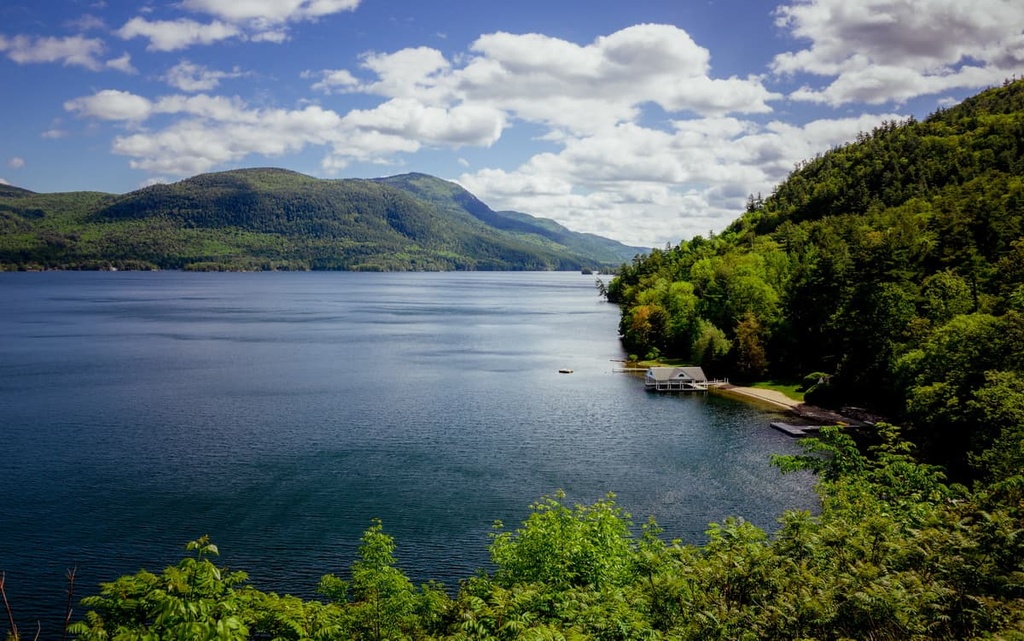
The Lake George Wild Forest is home to a number of wonderful trails for outdoor recreation. Here are a few of the trails that you can find within the forest that are worth checking out during your visit to the region.
Buck Mountain is the fifth-tallest and the fourth-most prominent peak in the forest. The trail up to the summit begins along the eastern shores of Lake George. This trail climbs steadily through the forested landscape and slowly steepens as you get closer to the summit.
After a few small creek crossings, the forest canopy above this trail begins to thin, revealing views of Lake George and the surrounding Adirondack Park. Once at the summit, hikers can enjoy unobstructed views of the lake and its various small islands. This out-and-back hike is 7 miles (11.3 km) long round trip and it has 1,988 feet (606 m) of elevation gain.
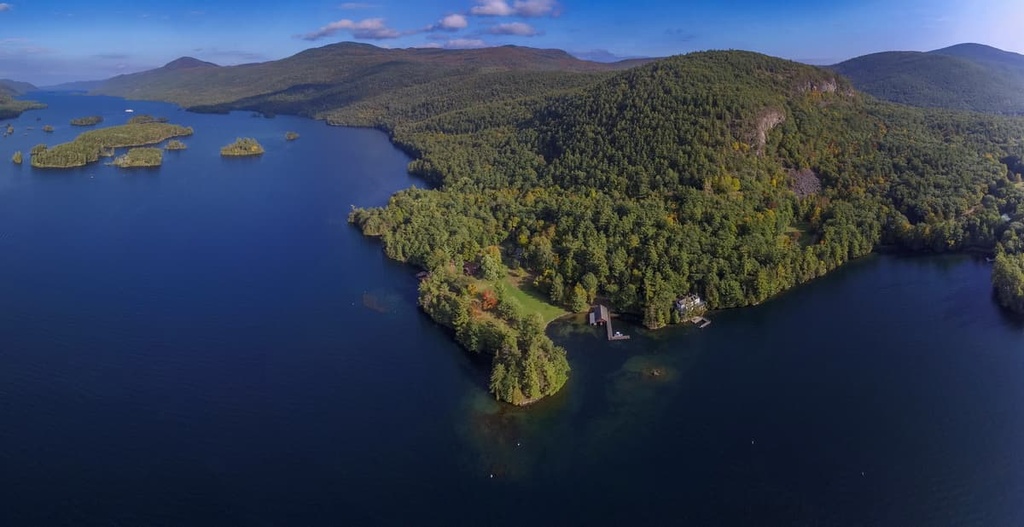
The route to the summit of Sleeping Beauty Mountain showcases the variety of landscapes found within the forest. The trail climbs steadily throughout, passing through forested areas, swamps, creeks, and ponds. Switchbacks on this trail climb steeply to the summit of the peak where hikers are rewarded with views of Lake George.
On a clear day, hikers can see Crane Mountain to the west as well as Pico and Killington to the east. Near the summit, the trail loops around Bumps Lake. The route is 7 miles (11.3 km) in length and it has 1,341 feet (409 m) of elevation gain.
Black Mountain is the tallest and most prominent peak in the Lake George Wild Forest. The first section of the trail to its summit is relatively flat, though it starts to climb steeply as you make your way to the top.

Once at the summit, hikers can enjoy views of Lake George to the northeast and southwest as well as the rest of the Adirondack Park to the northwest. After you reach the summit, the trail follows a small loop past a series of ponds known as the Black Mountain Ponds. This trail is 7.7 miles (12.4 km) in length and it has 1,361 feet of elevation gain (415 m)
Looking for a place to stay near the Lake George Wild Forest? Here are some of the best cities and villages to check out in the region.
The town of Ticonderoga lies along the northern shores of Lake George, just to the south of Lake Champlain. The town is situated on the northern edge of the Lake George Wild Forest and the eastern edge of the Pharaoh Lake Wilderness. Though the town is home to around 3,200 full-time residents, each year, roughly 100,000 tourists visit the region.
![]()
Known for its close proximity to the Adirondack Park, Ticonderoga has become an ideal vacation spot for those in search of an outdoor recreation destination. In addition to the plethora of hiking, camping, and mountain biking opportunities available around Ticonderoga, visitors to the area can also enjoy boating, swimming, paddleboarding, and kayaking during the summer months.
Throughout the winter, the region around Ticonderoga features popular spots for snowshoeing and cross-country skiing. Nearby hot springs also offer visitors a relaxing way to end a day of exploring the Adirondacks and Lake George.
Other popular tourist attractions around the town of Ticonderoga include Mount Defiance, Fort Ticonderoga, Heritage Museum, La Chute River Trail, and the Star Trek Original Series Set Tour.
The city of Queensbury lies just to the south of Lake George near the southern edge of the Lake George Wild Forest. This quaint city is home to around 28,000 residents, and it provides easy access to the major hiking routes found along the eastern shores of Lake George.
Queensbury is also situated near the Great Sacandaga Lake, offering tourists even more options for outdoor recreation. The town features local shops and restaurants as well as a quieter atmosphere compared to nearby Saratoga Springs.
Visitors to Queensbury can enjoy the city’s many hiking trails as well as its kayaking, canoeing, golfing, and mountain biking opportunities. During the winter months, visitors in Queensbury can also enjoy the region’s many cross-country skiing trails and the downhill skiing slopes at West Mountain.

Explore Lake George Wild Forest with the PeakVisor 3D Map and identify its summits.








